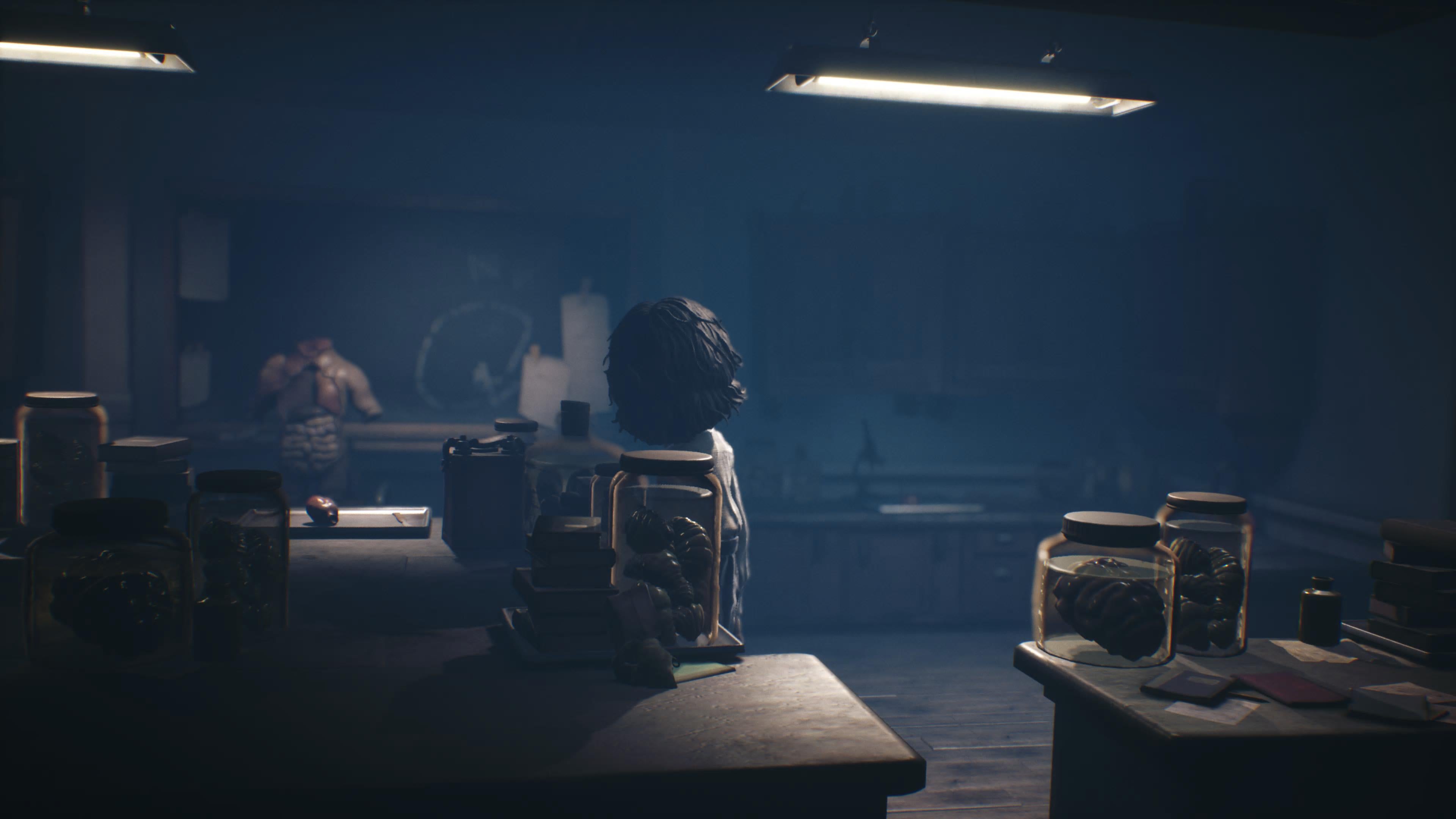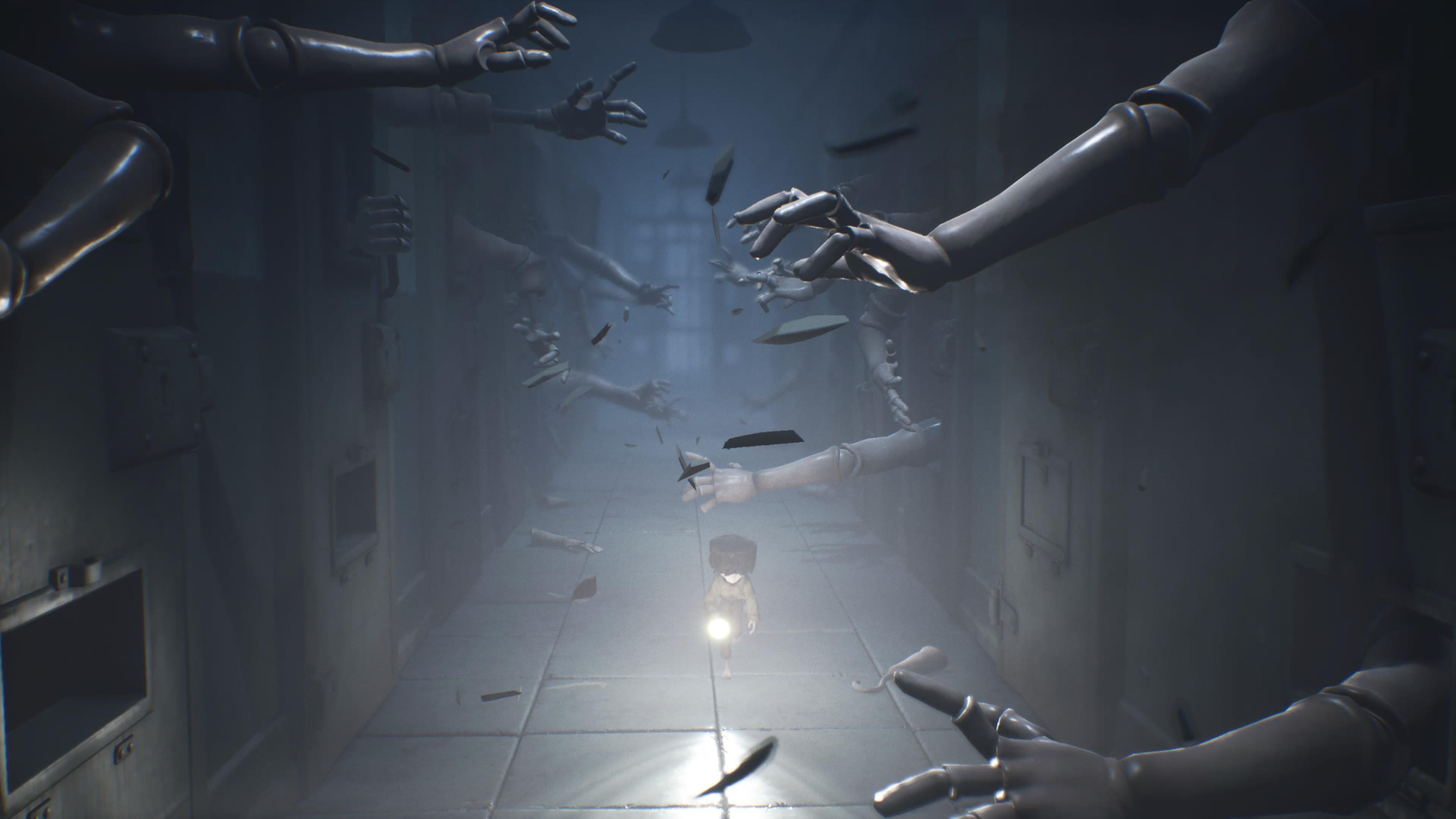Everything is oversized, as though we’ve stepped through the glass at the carnival’s hall of mirrors. Doors aren’t entryways, but mouths of caves. Each step on the staircase is a mini-mountain to scale. Later, when plastic aberrations shuffle in the darkness and you shatter the empty skulls of malevolent puppets with a hammer that’s bigger than you are, you’ll realise it’s not just the world that’s too big, but the risks, too. The horror. The dread. It’s a bleak, broken place utterly bereft of love and compassion, but full of terrifying things - things that shouldn’t exist, not now, not ever, not even in your most twisted nightmares.
When we first met Six, the tiny, solitary figure of Tarsier Studio’s first Little Nightmares offering, her world echoed with the flat sounds of her lonely, wet footsteps. In this second instalment, however, she’s accompanied by a partner, and it’s this friend - nicknamed Mono, although you’re never formally introduced - that you’ll inhabit for this adventure. Nary a word is exchanged between them - occasionally they’ll call softly to each other - but it’s a partnership that feels extraordinary from the off, a friendship forged in fear and an unfaltering determination to survive.
But beyond navigating this warped world as a duo rather than in isolation, there’s comparatively little else that’s new in Little Nightmares 2. While we’re no longer traversing the lilting corridors of The Maw, it’s a grim backdrop nonetheless, where hooks and nooses and bodies hang limply from the ceiling, broken TV sets litter the ground, and bright toys sit expectantly in spotlights, baiting unsuspecting children. And though the set-pieces are different and the streets are cold and empty - no, there are no enormous, pallid faces scrambling to gobble you down their gullets this time around - it feels instantly familiar, too.
In this regard, I reckon Little Nightmares is peerless. There’s not another studio that so flawlessly tickles my penchant for the macabre, and no other series where every single vignette is a pixel-perfect masterpiece. I fell for the debut game’s striking, dream-like design and grim tale completely and utterly, but it was an adventure I simultaneously loved and loathed. As a spectator, Little Nightmares is achingly perfect; as a player, however, its clumsy platforming and opaque signposting make for an infuriating experience.
While the puzzling is a tad different in the sequel - Mono has Six to help them out, after all, and this time you can periodically fight back at the things that want to squish you like a spider - the issues that plagued the first game linger on. The 2.5D perspective is ripe for showcasing those terrifically terrifying environments, but it makes for clumsy, off-kilter platforming, particularly in chase sequences that saw me all too often career into doorframes rather than doorways. The control scheme feels more like a game of Twister than anything remotely intuitive, and though brandishing weapons is intentionally unwieldy, the delay between hitting the button and swinging the weapon is outrageously imprecise, particularly at later stages when combat requires precision that’s laborious to pull off.
I know it’s intentional. I know it’s to enhance the dread that permeates everything, a way to imbue the player with a little of the panic coursing through Mono, that the weird angles and skewed perspectives carefully and calculatingly conspire to make you feel worse. But a couple of sequences are maddeningly hard to get through; I suspect I now know a particular section of the school better than my child’s face, so often did I have to replay it. Yes, it’s exhilarating when you finally scrape through, but success shouldn’t come down to sheer luck, should it?
The puzzling, too, can be frustrating. Whilst it’s refreshing to face challenges content to let you problem-solve in your own sweet time without the need for prompts or yes-you-can-interact-with-this item radiance, occasionally you’ll find the utter lack of signposting more taxing than teasing, while others - such as TV teleportation, and a delicious maze sequence towards the end - are pure genius.
But there are fail states and pseudo-scripted deaths, tiresome chase sequences with obscure finish lines, groan-worthy combat sections, and terrifying sentient mannequins that you can only ward off with a wobbly flashlight (and sometimes not even then). The unsettling atmosphere generates a very real, cloying sense of panic, panic so extreme that my sweaty fingers would sometimes slip off the controller, but other times, the combination of bad luck and timing would make me scream with rage.
That said, it’s lengthier than the first game and doesn’t outstay its welcome, but some might still feel cheated by its the 5-6 hour run-time (depending upon how stuck you get, I guess). Like its predecessor, it’s a chilling tale that’ll likely sit with you long after you set down the controller, and one that took a couple of unexpected turns I absolutely did not anticipate.
I suspect that if you loved your time on The Maw the first time around, there’s little doubt you’ll enjoy your return trip to Six’s wondrously warped world. But if you struggled to get along with the first instalment, there’s likely nothing new for you here; many of the enemies, whilst as twisted as anything yanked from the darkest depths of the collective minds of the Brothers Grimm, are recycled variants of those we’ve met before, and the platforming and puzzles - while certainly challenging - are much the same, too.
All of which leads me to something of a conundrum. While my every instinct is to tell you that Little Nightmares 2 is a frustrating encounter that’s likely better watched than played, I can’t help but admit I love it - fervently and ferociously - even if it was such an unmitigated ballache to play to completion.



